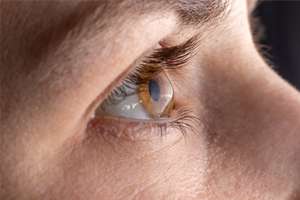
A Corneal Abrasion is a scratch on the surface of the cornea.
An ophthalmologist will treat the Corneal Abrasion based on the severity. Most likely they will prescribe a moisturizing eye drop or an antibiotic eye drop to prevent infection.
A Corneal Ulcer is an open sore on the cornea.
Generally, antibiotic, antifungal, or antiviral eye drops are the treatment most ophthalmologists will use to treat a Corneal Ulcer. In some cases, they may prescribe you an antifungal tablet, or they may treat you with an injection of medication near the eye. If a Corneal Ulcer cannot be healed with medication, a corneal transplant may be needed to keep your vision. To learn more about a Corneal Transplant, please click here.
Fuchs’ Dystrophy is a corneal disease where cells in the endothelium gradually die off. These are the cells that would normally pump fluid out to keep the cornea clear. When the cells in the endothelium die off, the fluid builds up and the cornea begins to swell and becomes puffy causing vision to become cloudy or hazy.
In the first stage, few, if any, symptoms will be noticed. Vision will generally be hazy when you wake up in the morning, but can get better throughout the day.
In the second stage, vision will remain blurry throughout the day. The second stage occurs when too much fluid builds up while you are sleeping and not enough of the fluid dries up throughout the day. During the second stage, tiny blisters may also form in the cornea, which can eventually break open if they get big enough, causing pain in the eye.
Stage 1 Symptoms:
Stage 2 Symptoms:
Currently, there is no cure for Fuchs’ Dystrophy, however, there are treatments to help control your vision problems. An ophthalmologist will potentially prescribe you an eye drop medicine or ointment to help reduce the swelling of the cells in the cornea. If the disease is severe enough, a full corneal transplant may be considered. To learn more about a Corneal Transplant, please click here.
Keratoconus is when the cornea begins to thin and bulges out like a cone. When the corneal changes shape, it brings light rays coming into the eye out of focus, causing blurry and distorted vision.
There is not a known reason for why people develop Keratoconus, but it is believed to possibly be genetic. Keratoconus has also been associated with excessive eye rubbing and eye allergies.
Treatment of Keratoconus depends on the severity of the symptoms. In the mild stages of Keratoconus, vision may be corrected with glasses. In severe stages of Keratoconus, a corneal transplant may be the only solution to correct vision. To learn more about a Corneal Transplant, please click here.
A Pinguecula is a growth that is a deposit of protein, fat, or calcium that looks like a yellow spot or a bump on the conjunctiva.
A Pterygium is a growth of fleshy tissue that can start as a Pinguecula. It can remain small or it can grow large enough to cover part of the cornea, affecting your vision.
An ophthalmologist will most likely prescribe lubrication or steroid eye drops to treat a Pinguecula or Pterygium. If a Pterygium grows large enough, then an ophthalmologist may suggest surgery to remove it.
Salzmann’s Degeneration is when small, white bumps form on the surface of the cornea. In mild cases, the bumps are small and do no usually cause symptoms, but if the bumps grow larger or closer to the center of the cornea, there may be some discomfort or a decrease in vision.
Treatment for Salzmann’s Degeneration will depend on the severity of your symptoms. If you have a mild case, then generally, no treatment is needed other than regular eye exams with your ophthalmologist to monitor your condition. If your case is more severe, your ophthalmologist may suggest surgery to scrape the bumps off the surface of the cornea.
If you believe that you have any of these corneal conditions, please call our office at (864) 583-5312 to schedule an appointment.
Dr Berry is the best. He is so thorough.